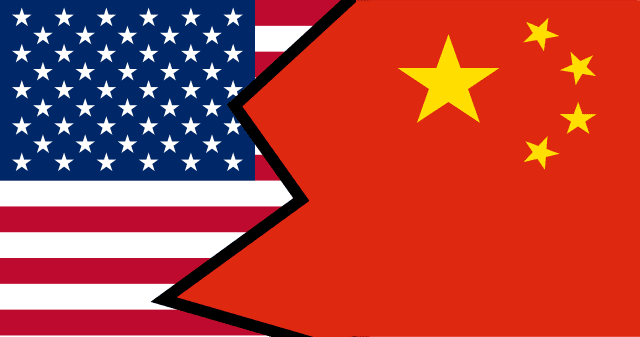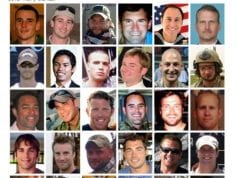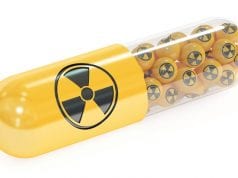
June 1989. After the Chinese government turns on pro-democracy demonstrators in Tiananmen Square, the Bush Administration imposes sanctions on China, including a moratorium on high-level visits and military cooperation.

March 9, 1992. While campaigning for President, Bill Clinton says, “I do not believe we should extend ‘Most Favored Nation’ status to China unless they make significant progress in human rights, arms proliferation and fair trade.”
October 1, 1992. Clinton tells a Milwaukee crowd, “There is no more striking example of Mr. Bush’s indifference toward democracy than his policy toward China…The Chinese leadership still sells missiles and nuclear technology to Middle Eastern dictators who threaten us and our friends…I do believe that our nation has a higher purpose than to coddle dictators.”
January 22, 1993. The day before the anniversary of Roe v. Wade, President Clinton signs an order reversing the ban on funding for international abortion programs. The head of the UN Fund for Population Activities (UNFPA), which President Reagan accused of supporting coercive abortion in China, attends the signing ceremony.
June 3, 1993. President Clinton signs an executive order extending MFN to China on the condition that MFN will not be renewed in 1994 if human rights do not improve.
August 1993. After learning that China transferred missile technology to Pakistan, the United States bars the export of American-made high-technology, including satellite-launching equipment, rocket systems, flight control and other computer systems.
September-October 1993. According to the April 13, 1998 New York Times, Michael Armstrong, CEO of Hughes Electronics, which had worked with China Aerospace to launch American satellites, wrote two “blunt” letters to President Clinton in the early fall of 1993, reminding him of “his support” and saying that the sanctions were damaging his company. Together with Loral Space and Communications, Hughes had contributed $2.5 million to the Democratic Party since 1991.
September 29, 1993. President Clinton announces a plan, which Commerce Secretary Ron Brown helped develop, to liberalize Coordinating Committee for Multilateral Export Controls restrictions on computers and other high technology equipment to China and other nations.
October 5, 1993. China conducts an underground nuclear weapons test.
November 12, 1993. President Clinton grants Hughes and Martin-Marietta waivers to launch US satellites from Chinese rockets.
November 17, 1993. Secretary of State Warren Christopher indicates that if China will discuss its transfer of missile technology to Pakistan, the United States will allow two American satellites to be exported.
November 18, 1993. President Clinton decides to permit the sale to China of an $8 million supercomputer capable of performing 958 million calculations per second. He also lifts the ban on selling components for China’s nuclear power plants.
November 19, 1993. Chinese President Jiang Zemin meets informally with President Clinton at a conference for Asian-Pacific Economic Cooperation (APEC) leaders. Afterward, Clinton says, “I think anybody should be reluctant to isolate a country as big as China with the potential China has for good.”
January 1994. The Clinton administration authorizes the Chinese launch of three satellites, including one Hughes satellite. The same month, the United States resumes financing for the UNFPA, which funds China’s population control program that includes coercive abortion.
March 30, 1994. The United States lifts export restrictions on telecommunications and computer technology imposed by the Coordinating Committee for Multilateral Export Controls. China and the former Soviet block are the primary beneficiaries.
May 3, 1994. President Clinton tells CNN, “I do not seek, nor would it be proper, for the United States or any other nation to tell a great nation like China how to conduct all its internal affairs, to treat all its citizens or what laws it should have. That would be wrong.”
June 2, 1994. President Clinton announces that he will sign an executive order extending MFN to China for another year. Clinton says that he will no longer link trade with human rights in evaluating China’s MFN status.
September 1994. Loral CEO Bernard Schwartz travels to China with Commerce Secretary Ron Brown on a trade mission. From 1992 to the present, Schwartz has given $1.9 million to the Democratic Party.
October 4, 1994. US Secretary of State Warren Christopher and Chinese Foreign Minister Qian Qichen sign an agreement ending the ban on export to China of US high-technology, including satellite launch equipment and computer technology.
October 7, 1994. China conducts an underground nuclear test.
October 18, 1994. US Defense Secretary William Perry and Chinese military leaders agree to begin high-level briefings on each other’s military strategy. Perry tells a news conference, “We are putting into place one dimension of the overall policy of President Clinton’s program of broad, constructive engagement with China.”
January 26, 1995. Chinese Long March rocket carrying an Apstar-2 satellite manufactured by Hughes Space and Communications, a unit of General Motors, explodes above its launch pad.
March 6, 1995. Johnny Chung, who according to the New York Times, has since admitted to funneling funds from the Chinese Army to the Democratic Party, receives a $150,000 wire transfer from the Chinese government owned Bank of China.
March 8, 1995. Chung meets with Hillary Clinton’s aide Evans Ryan at the White House and offers assistance. According to the Los Angeles Times, “Ryan left for about 15 to 20 minutes and returned saying she had spoken with [Mrs. Clinton’s Chief of Staff Maggie] Williams. Then she said, “Maybe you can help us.”. The aide told Chung that “the First Lady had some debts with the DNC.”
March 9, 1995. Chung returns to Mrs. Clinton’s office with a $50,000 check made out to the DNC, which Maggie Williams accepts.
March 11, 1995. Chung takes his friends, including Hongye Zheng, an advisor to the Chinese government owned China Ocean Shipping Co. (COSCO) to a taping of President Clinton’s radio address in the Oval Office.
May 15, 1995. China explodes a nuclear bomb in an underground test.
May 26, 1995. In a White House announcement, President Clinton says, “I have decided that the United States should renew ‘Most Favored Nation’ trading status toward China…I am moving, therefore, to delink human rights from the annual extension of ‘Most Favored Nation’ trading status for China.”
July 21-26, 1995. China conducts tests of six surface-to-surface ballistic missiles off the coast of Taiwan.
August 15-25, 1995. China conducts off-shore military exercises 90 miles north of Taiwan.
August 17, 1995. China explodes a nuclear bomb in an underground test.
August 25, 1995. In spite of Republican opposition, President Clinton announces that the First Lady will attend the UN Conference on Women in China.
September 1995. In a meeting with public officials from Long Beach, California, President Clinton pushes for the Long Beach Naval Station to be leased to the Chinese government owned COSCO.
October 6, 1995. President Clinton loosens restrictions on the sale of high-performance computers. China is allowed to import ../../timeless/how-china-conquered-america746/computers of less than 7_000 million theoretical operations per second for civilian purposes.css; they can get greater capacity with special permission from the Commerce Department. The computers offer China’s missile program increased simulation capability in assessing nuclear blast damage and kill zones.
October 9, 1995. After pressure from producers of communications satellites prompted a review of existing restrictions, Secretary of State Warren Christopher issues an order keeping commercial satellites on the munitions list, an inventory of strategic military and intelligence technology, and reaffirming the jurisdiction of the State Department in the matter. According to the May 17, 1998 New York Times, Christopher wrote in a classified memorandum that lifting the export limitation would “raise suspicions that we are trying to evade China sanctions”. The Commerce Department appeals Christopher’s decision to the President.
October 24, 1995. Jiang Zemin and Clinton meet in New York City. Their meeting was scheduled at the New York Public Library, but was moved at the last minute after Chinese officials learned that the library was exhibiting photographs of the pro-democracy protestors in Tiananmen Square.
February 6, 1996. Wang Jun, head of the China International Trade and Investment Corporation and holder of a multibillion dollar interest in one of Hong Kong’s leading satellite companies, meets with Secretary of Commerce Ron Brown at the Commerce Department. Wang, called a “Chinese arms dealer” in a Senate Committee Report, later attends a White House Coffee with President Clinton, escorted by Charlie Trie, a DNC fundraiser who raised $640,000 for the President’s Legal Defense Fund, all of which was returned after the source could not be verified. Tried fled to China rather than face questioning, but has since returned under indictment. The same day, President Clinton approves the launch of four American satellites by Chinese rockets.
February 15, 1996. A Chinese Long March 3B carrying a $200 million Loral satellite explodes 22 seconds after lilftoff.
March 14, 1996. President Clinton shifts control over regulating the export of communications satellites from the State Dept. which was primarily concerned with national security aspects of such exports, to the Commerce Dept., which is concerned with the economic benefits.
May 10, 1996. The Loral-led review commission investigating the February rocket explosion completes and passes on to Chinese officials its report, which according to the April 13, 1998 New York Times, discusses “sensitive aspects of the rocket’s guidance and control systems, which is an area of weakness in China’s missile programs.” The New York Times says that a Pentagon report concludes that, as a result of this technology transfer, “United States national security has been harmed”.
May 23, 1996. President Clinton calls for renewal of MFN for China, saying that renewal would not be “a referendum on all China’s policies,” but “a vote for America’s interests.”
June 8, 1996. China conducts an underground nuclear test.
July 21, 1996. Johnny Chung, according to the New York Times, brings Liu Chao-ying to two DNC fundraisers, including a $25,000 per couple dinner. Liu Chao-ying is a Lieutenant Colonel in the People’s Liberation Army and an executive at China Aerospace, which owns the Great Wall Industry Corp. that makes Long March rockets. Her father is the top commander of Chinese military forces. The New York Times says that Chung has told the Justice Dept. that Liu gave him the better part of $100,000 he contributed to the DNC in the latter part of 1996, and that the source of the money was the PLA.
July 29, 1996. China declares a moratorium on nuclear testing after conducting another nuclear test.
August 8, 1996. According to AP, Clinton meets again with Long Beach officials to advocate turning over the naval base to COSCO.
September 24, 1996. At the UN, President Clinton joins with the foreign ministers of China, France, Russia and Great Britain in signing the Comprehensive Test Ban Treaty forbidding all testing of nuclear weapons.
November 5, 1996. President Clinton wins reelection. According to the Center for Responsive Politics, the single largest Democratic donor during the election cycle was Loral CEO Bernard Schwartz, who gave $632,000 in ‘soft money’ to the Democratic Party between 1995 and 1996. The State Dept. issues regulations shifting responsibility for satellite launching licenses to the Commerce Dept.
January 1997. The Panamanian government awards the contract to operate the Atlantic and Pacific ports of the Panama Canal to a Hong Kong company, Hutchison Whampoa. China takes control of Hong Kong six months later. The United States, which is set to relinquish control of the canal next year, does not protest.
March 25, 1997. While in Beijing for a meeting with Premier Li Peng and President Jiang Zemin, Vice President Gore attends signing ceremonies for Boeing’s $685 million sale of five jetliners to China’s state-owned Civil Aviation Administration as well as a $1.3 billion joint venture between General Motors and China’s state-owned Shanghai Automotive Industry Corp.
May 1997. According to the April 13, 1998 New York Times, a classified Pentagon report reveals that Hughes and Loral scientists “had turned over expertise that significantly improved the reliability of China’s nuclear missiles” following the February 1996 rocket explosion. Hughes and Loral deny the New York Times report when it is published in 1998.
May 19, 1997. President Clinton announces that he will authorize MFN renewal for China.
October 1997. Chinese President Jiang Zemin makes a state visit to the United States. During the trip, he stops at a Hughes site to discuss satellites.
January 15, 1998. After China promises that it will no longer aid Iran’s nuclear program, President Clinton certifies that China is a reliable partner for nuclear technology exchange.
February 19, 1998. Despite opposition from the Justice Dept, President Clinton signs a waiver approving the launch of a Loral satellite from a Chinese rocket and reportedly authorizing the transfer of the same type of technology that the Pentagon said had “harmed” US security and that the Justice Dept. was investigation Loral and Hughes for their illegally transferring in 1996.
March 14, 1998. President Clinton announces that, after backing it since the Tiananmen massacre, the United States will no longer sponsor a UN resolution denouncing China’s human rights practices.
May 17, 1998. President Clinton responds in lawyerly language to allegations that Chinese campaign funds affected American foreign policy, “All the foreign policy decisions we made, we based on what we believed, I and the rest of the administration, were in the interests of the American people.”
This article was originally published in a 1999 printed edition of Human Events and titled The Real Bill Clinton Scandal.








